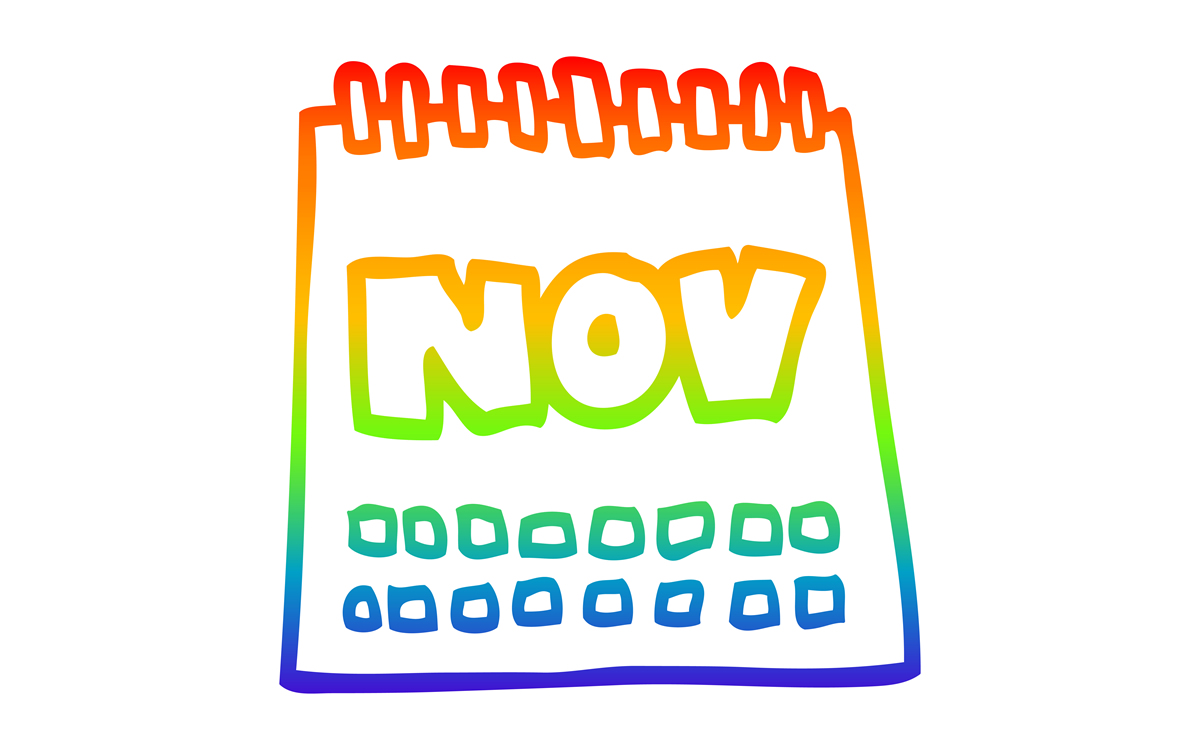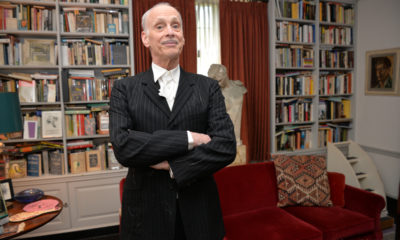Arts & Entertainment
Teased up but Waters-downed
Signature’s ‘Hairspray’ adept and entertaining but distanced from source material

‘Hairspray’
Signature Theatre
4200 Campbell Ave., Arlington
Through Jan. 29
$63 and up
703-820-9771
signature-theatre.org

Carolyn Cole, center, as Tracy Turnblad with the cast of ‘Hairspray.’ (Photo by Christopher Mueller; courtesy Signature)
“Hairspray’s” chubby heroine Tracy Turnblad never set out to be an activist. She just wanted to dance on TV.
Like a lot of teens, Tracy is into pop music, cute boys and the latest fashion trends which, in 1962 Baltimore, means big hair. But more than anything she’d like to be a regular dancing on “The Corny Collins Show” (think “American Bandstand”). Despite being overweight, Tracy realizes her dream and emerges as a breakout star. Not content to make inroads exclusively in size inclusiveness, she pushes for the show to integrate — Tracy wants her new black friends (from whom she learns the latest moves) to be on air every afternoon and not just once a month on “Negro Day.” Risking her newfound fame, she leads a protest against the TV station’s racist policies and finds teen romance in the process.
Based on gay auteur John Waters’ same-titled 1988 film (see our Waters’ interview here), the multiple Tony Award-winning musical “Hairspray” is an anti-segregation story with a good beat you can dance to. Marc Shaiman, the show’s composer and its co-lyricist with his musical and life partner Scott Wittman, have drawn inspiration from early ‘60s pop and R&B, but the high energy and heartwarming score is still distinctly Broadway. Highlights include “Good Morning Baltimore,” “Welcome to the ‘60s” and “You Can’t Stop the Beat.”
Admirably staged by Signature’s gay artistic director Eric Schaeffer, the production is relatively intimate and incessantly entertaining. Per usual, Schaeffer has brought together an able creative team. Karma Camp and Brianne Camp’s vigorous choreography reads like a slice from a great ‘60s dance party. John Kalbfleisch is the musical director and pianist Jenny Cartney conducts a top-notch nine-piece orchestra. The witty, colorful costumes are by Kathleen Geldard and set designer Daniel Conway provides a gritty, midnight blue Baltimore streetscape dominated by a faded advert for Ultra Clutch Hairspray — so much better than the New York production’s Day-Glo explosion.
A talented mix of familiar and new faces comprises the 25-person cast including big-voiced Carolyn Cole as the indomitable, bubbly Tracy. Sherri L. Edelen is wonderfully corrupt as villainess Velma Von Tussle, the TV show’s racist producer. Lynn Audrey Neal plays both the butch gym teacher and the butch — but tap dance-loving — jail matron. Nova Y. Payton’s Motormouth Maybelle brings down the house with a powerful rendition of the heartfelt spiritual “I Know Where I’ve Been.”
Lauren Williams is terrific as goony Penny, Tracy’s loyal best friend who, despite the hysterical prejudices of her tyrannical mother (Neal again), finds love with African-American teen Seaweed (the excellent James Hayden Rodriquez) and blossoms into a happy and fashionable “checkerboard chick.”
In a bit of stunt casting, national radio and public TV personality Robert Aubry Davis (who’s straight) swaps out his usual cultured tones for more “Balmer, hon” sounds and wears a dress in the role of Tracy’s mother Edna. While his portrayal of the agoraphobic housewife who takes in washing isn’t as layered as those of more professional actors like drag superstar Divine and drag-acquainted Harvey Fierstein who played Edna in the original film and on Broadway respectively (John Travolta donned the triple X housedress for the musical film version), Davis’ wistful Edna grows on you.
Waters’ version was one of the notorious director’s first ventures into the mainstream, so it’s less raunchy than his earlier stuff, and the musical “Hairspray’s” libretto is a tad cleaner still. But the hilarious Waters’ worldview remains. Tracy’s mother pops diet pills. Her father sells whoopee cushions. Girls stuff their bras and boys stuff their briefs. And in her struggle to be both stylish and do the right thing, Tracy ends up in high school detention and even jail. But the more the plus-size teen defies authority, the better life is for her and those around her, and the higher her hair rises.
Movies
Superb direction, performances create a ‘Day’ to remember
A rich cinematic tapestry with deep observations about art, life, friendship

According to writer/director Ira Sachs, “Peter Hujar’s Day” is “a film about what it is to be an artist among artists in a city where no one was making any money.” At least, that’s what Sachs – an Indie filmmaker who has been exploring his identities as both a gay and Jewish man onscreen since his 1997 debut effort, “The Delta” – told IndieWire, with tongue no doubt firmly planted in cheek, in an interview last year.
Certainly, money is a concern in his latest effort – which re-enacts a 1974 interview between photographer Peter Hujar (Ben Whishaw) and writer Linda Rosenkrantz (Rebecca Hall), as part of an intended book documenting artists over a single 24-hour period in their lives – and is much on the mind of its titular character as he dutifully (and with meticulous detail) recounts the events of his previous day during the course of the movie. To say it is the whole point, though, is clearly an overstatement. Indeed, hearing discussions today of prices from 1974 – when the notion of paying more than $7 for Chinese takeout in New York City seemed outrageous – might almost be described as little more than comic relief.
Adapted from a real-life interview with Hujar, which Rosenkrantz published as a stand-alone piece in 2021 (her intended book had been abandoned) after a transcript was discovered in the late photographer’s archives, “Peter Hujar’s Day” inevitably delivers insights on its subject – a deeply influential figure in New York culture of the seventies and eighties, who would go on to document the scourge of AIDS until he died from it himself, in 1987. There’s no plot, really, except for the recalled narrative itself, which involves an early meeting with a French journalist (who is picking up Hujar’s images of model Lauren Hutton), an afternoon photo shoot with iconic queer “Beat Generation” poet/activist Allen Ginsburg, and an evening of mundane social interaction over the aforementioned Chinese food. Yet it’s through this formalized structure – the agreed-upon relation of a sequence of events, with the thoughts, observations, and reflections that come with them – that the true substance shines through.
In relaying his narrative, Hujar exhibits the kind of uncompromising – and slavishly precise – devotion to detail that also informed his work as a photographer; a mundane chronology of events reveals a universe of thought, perception, and philosophy of which most of us might be unaware while they were happening. Yet he and Rosenkrantz (at least in Sachs’ reconstruction of their conversation) are both artists who are keenly aware of such things; after all, it’s this glimpse of an “inner life,” of which we are rarely cognizant in the moment, that was/is their stock-in-trade. It’s the stuff we don’t think of while we’re living our lives: the associations, the judgments, the selective importance with which we assign each aspect of our experiences, that later become a window into our souls – if we take the opportunity to look through it. And while the revelations that come may occasionally paint them in a less-than-idealized light (especially Hujar, whose preoccupations with status, reputation, appearances, and yes, money, often emerge as he discusses the encounter with Ginsberg and his other interactions), they never feel like definitive interpretations of character; rather, they’re just fleeting moments among all the others, temporary reflections in the ever-ongoing evolution of a lifetime.
Needless to say, perhaps, “Peter Hujar’s Day” is not the kind of movie that will be a crowd-pleaser for everyone. Like Louis Malle’s equally acclaimed-and-notorious “My Dinner With Andre” from 1981, it’s essentially an action-free narrative comprised entirely of a conversation between two people; nothing really happens, per se, except for what we hear described in Hujar’s description of his day, and even that is more or less devoid of any real dramatic weight. But for those with the taste for such an intellectual exercise, it’s a rich and complex cinematic tapestry that rewards our patience with a trove of deep observations about art, life, and friendship – indeed, while its focus is ostensibly on Hujar’s “day,” the deep and intimate love between he and Rosenkrantz underscores everything that we see, arguably landing with a much deeper resonance than anything that is ever spoken out loud during the course of the film – and never permits our attention to flag for even a moment.
Shooting his movie in a deliberately self-referential style, Sachs weaves the cinematic process of recreating the interview into the recreation itself, bridging mediums and blurring lines of reality to create a filmed meditation that mirrors the inherent artifice of Rosenkrantz’s original concept, yet honors the material’s nearly slavish devotion to the mundane minutiae that makes up daily life, even for artists. This is especially true for both Hujar and Rosenkrantz, whose work hinges so directly to the experience of the moment – in photography, the entire end product is tied to the immediacy of a single, captured fragment of existence, and it is no less so for a writer attempting to create a portrait (of sorts) composed entirely of fleeting words and memories. Such intangibles can often feel remote or even superficial without further reflection, and the fact that Sachs is able to reveal a deeper world beyond that surface speaks volumes to his own abilities as an artist, which he deploys with a sure hand to turn a potentially stagnant 75 minutes of film into something hypnotic.
Of course, he could not accomplish that feat without his actors. Whishaw, who has proven his gifts and versatility in an array of film work including not only “art films” like this one but roles from the voice of Paddington Bear to “Q” in the Daniel Craig-led “James Bond” films, delivers a stunning performance, carrying at least 75% of the film’s dialogue with the same kind of casual, in-the-moment authenticity as one might expect at a dinner party with friends; and though Hall has less speaking to do, she makes up for it in sheer presence, lending a palpable sense of respect, love, and adoration to Rosenkrantz’s relationship with Hujar.
In fact, by the time the final credits role, it’s that relationship that arguably leaves the deepest impression on us; though these two people converse about the “hoi polloi” of New York, dropping legendary names and reminding us with every word of their importance in the interwoven cultural landscape – evoked with the casual air of everyday routine before it becomes cemented as history – of their era, it’s the tangible, intimate friendship they share that sticks with us, and ultimately feels more important than any of the rest of it. For all its trappings of artistic style, form, and retrospective cultural commentary, it’s this simple, deeply human element that seems to matter the most – and that’s why it all works, in the end. None of its insights or observations would land without that simple-but-crucial link to humanity.
Fortunately, its director and stars understand this perfectly, and that’s why “Peter Hujar’s Day” has an appeal that transcends its rarified portrait of time, place, and personality. It recognizes that it’s what can be read between the lines of our lives that matters, and that’s an insight that’s often lost in the whirlwind of our quotidian existence.
Out & About
Gala Hispanic Theatre’s Flamenco Festival returns

Gala Hispanic Theater will host the 21st Annual “Fuego Flamenco Festival” from Thursday, Nov. 6 to Saturday, Nov. 22.
The festival will feature American and international artists who will gather in the nation’s capital to celebrate the art of Flamenco. Guests can save 20% on tickets with a festival pass.
The festival kicks off now through Nov. 10 with the D.C. premiere of Crónica de un suceso, created, choreographed and performed by Rafael Ramírez from Spain, accompanied by renowned flamenco singers and musicians. In this new show, Ramírez pays homage to the iconic Spanish Flamenco artist Antonio Gades who paved the way for what Flamenco is today. GALA’s engagement is part of an eight-city tour of the U.S. by Ramírez and company.
The magic continues Nov. 14-16 with the re-staging of the masterpiece Enredo by Flamenco Aparicio Dance Company, a reflection of the dual nature of the human experience, individual and social, which premiered at GALA in 2023.
For more information, visit the theatre’s website.

Friday, November 7
“Center Aging Friday Tea Time” will be at 12 p.m. in person at the DC Center for the LGBT Community’s new location at 1827 Wiltberger St., N.W. To RSVP, visit the DC Center’s website or email [email protected].
Go Gay DC will host “LGBTQ+ Community Social” at 7 p.m. at Silver Diner Ballston. This event is ideal for making new friends, professional networking, idea-sharing, and community building. This event is free and more details are available on Eventbrite.
Saturday, November 8
Go Gay DC will host “LGBTQ+ Community Brunch” at 12 p.m. at Freddie’s Beach Bar & Restaurant. This fun weekly event brings the DMV area LGBTQ+ community, including allies, together for delicious food and conversation. Attendance is free and more details are available on Eventbrite.
Sunday Supper on Saturday will be at 2 p.m. at the DC Center for the LGBT Community. This event will be full of food, laughter and community. For more information, email [email protected].
Monday, November 10
“Center Aging: Monday Coffee Klatch” will be at 10 a.m. on Zoom. This is a social hour for older LGBTQ adults. Guests are encouraged to bring a beverage of choice. For more information, contact Adam ([email protected]).
“Soulfully Queer: LGBTQ+ Emotional Health and Spirituality Drop-In” will be at 3 p.m. at the DC Center for the LGBT Community. This group will meet weekly for eight weeks, providing a series of drop-in sessions designed to offer a safe, welcoming space for open and respectful conversation. Each session invites participants to explore themes of spirituality, identity, and belonging at their own pace, whether they attend regularly or drop in occasionally. For more details visit the DC Center’s website.
Genderqueer DC will be at 7 p.m. on Zoom. This is a support group for people who identify outside of the gender binary, whether you’re bigender, agender, genderfluid, or just know that you’re not 100% cis. For more details, visit genderqueerdc.org or Facebook.
Wednesday, November 12
Job Club will be at 6 p.m. on Zoom. This is a weekly job support program to help job entrants and seekers, including the long-term unemployed, improve self-confidence, motivation, resilience and productivity for effective job searches and networking — allowing participants to move away from being merely “applicants” toward being “candidates.” For more information, email [email protected] or visit thedccenter.org/careers.
“Gay Men Speed Dating” will be at 7 p.m. at Public Bar Live. This is a fresh alternative to speed dating and matchmaking in a relaxed environment. Tickets start at $37 and are available on Eventbrite.
Thursday, November 13
The DC Center’s Fresh Produce Program will be held all day at the DC Center for the LGBT Community. People will be informed on Wednesday at 5 p.m. if they are picked to receive a produce box. No proof of residency or income is required. For more information, email [email protected] or call 202-682-2245.
Virtual Yoga Class will be at 7 p.m. on Zoom. This is a free weekly class focusing on yoga, breathwork, and meditation. For more details, visit the DC Center for the LGBT Community’s website.
-

 District of Columbia3 days ago
District of Columbia3 days ago‘Sandwich guy’ not guilty in assault case
-

 Sports3 days ago
Sports3 days agoGay speedskater racing toward a more inclusive future in sports
-

 Celebrity News5 days ago
Celebrity News5 days agoJonathan Bailey is People’s first openly gay ‘Sexiest Man Alive’
-

 Michigan5 days ago
Michigan5 days agoFBI thwarts Halloween terror plot targeting Mich. LGBTQ bars




















